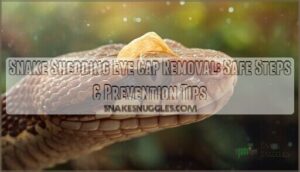This site is supported by our readers. We may earn a commission, at no cost to you, if you purchase through links.

Baby snakes need meals twice a week since they’re growing fast, while adults can go a week or two between feedings.
Larger snakes or less active ones often eat less frequently.
Always match the prey size to your snake’s girth—too big, and it’s unsafe; too small, and they’ll stay hungry.
Frozen-thawed prey is best to avoid parasites, and using feeding tongs keeps things safe for both of you.
Female snakes may need extra meals during breeding season.
Keep an eye on their appetite and adjust as needed for a healthy, happy snake.
Table Of Contents
- Key Takeaways
- Snake Feeding Basics
- Prey Options Explained
- Feeding Techniques Matter
- Snake Size Feeding Guide
- Nutrition and Supplements
- Feeding Problems Solved
- Feeding Environment Tips
- Monitoring Feeding Habits
- Frequently Asked Questions (FAQs)
- How often should you feed snakes?
- How do you know your snake is hungry?
- How soon after a snake eats does it poop?
- Should I feed my snake at night or day?
- How to safely thaw frozen snake prey?
- What temperature should prey be before feeding?
- Can snakes eat prey other than rodents?
- How to store frozen prey long-term?
- What signs indicate prey size is inappropriate?
- Conclusion
Key Takeaways
- You’ll need to adjust your snake’s feeding schedule based on its age, size, and species to ensure it stays healthy and happy.
- It’s crucial to match the prey size to your snake’s girth, as prey that’s too big can be unsafe and prey that’s too small won’t satisfy their hunger.
- You should monitor your snake’s appetite and adjust its feeding schedule as needed, taking into account factors like breeding season, temperature changes, or illness that might affect its hunger signs.
- To keep your snake healthy, you’ll want to create a calm and stress-free feeding environment, whether that’s inside or outside its enclosure, and make sure to handle the prey safely to avoid transferring your scent to it.
Snake Feeding Basics
Feeding your pet snake starts with understanding its basic dietary needs and natural habits.
Most snakes thrive on whole prey like mice or rats, with feeding schedules depending on their species, size, and age.
Primary Food Sources
Snakes thrive on a carnivorous diet, with prey types like mice, rats, or chicks forming the foundation of their pet snake diet.
Frozen-thawed food is safer and guarantees high food quality, free from parasites.
Feeding variety matters—some species may need specific meat sources like lizards or birds.
Whole prey offers balanced nutrient value, supporting your snake feeding schedule and overall health.
Understanding snake food options is essential for a well-planned diet.
Feeding Frequency Guidelines
After choosing the right food, understanding a snake feeding schedule is key.
Meal frequency depends on size and age. Here’s a quick feeding frequency guide:
- Baby snakes: Twice weekly for proper growth.
- Juveniles: Weekly meals support steady feeding cycles.
- Adults: Every 7–14 days, depending on species.
- Large snakes: Monthly feeding aligns with slower nutrient timing.
Stick to frozen thawed food for safety, as it is crucial for the health of your snake, and remember that a proper feeding schedule is essential for their well-being.
Dietary Needs Variation
Not all snakes eat the same way. A species diet can range from rodents to insects or even snails, depending on their natural prey variety.
Age factors also influence snake feeding frequency—babies often need meals twice a week, while adults eat less often.
Feeding adaptation makes sure proper nutrient needs are met, so follow specific dietary needs for balanced snake nutrition.
Prey Options Explained
Understanding prey options is key to snake feeding. Your choices depend on species, size, and feeding frequency.
Common prey types include frozen-thawed mice, rats, insects, or even specialized items like snails. Here’s a quick breakdown:
- Frozen Prey: Convenient, safe, and ideal for snake nutrition.
- Live Prey: Risky but sometimes necessary for picky eaters.
- Insects: Great for smaller snakes needing food variety.
- Prey Size: Match prey to your snake’s girth for safe feeding.
Considering the snake’s diet and prey preferences is critical for a balanced diet. Thoughtful feeding choices guarantee your snake thrives.
Feeding Techniques Matter
How you feed your snake is just as important as what you feed it. Using proper techniques keeps your snake safe, healthy, and stress-free during meals.
Handling Pre-Killed Prey
When using prekilled prey, proper handling is key.
Always store prey in a freezer to maintain freshness and snake nutrition advice.
You can buy prekilled rat food online.
Thawing methods like warm water guarantee safe feeding. Use feeding tools, such as tongs, to avoid scent transfer and bites.
Prey handling should follow safety precautions to protect you and your pet. Prekilled rats are safer than feeding live prey.
Avoiding Live Prey Risks
Injury prevention is key when feeding your snake. Live prey can bite back, causing wounds or even disease transmission. Feeding live prey can be dangerous, learn more about live prey dangers.
Opt for frozen prey to guarantee prey safety and stress reduction. Consider these snake feeding tips:
- Prekilled prey eliminates ethical concerns and reduces risks.
- Live prey may harm your snake if left unattended.
- Frozen prey aligns with safe snake feeding frequency practices.
Reducing Scent Transfer
To keep your snake’s feeding routine safe, you’ll want to minimize scent transfer between your hands and the prey.
Use dedicated feeding tongs when offering prey items – this helps prevent your snake from associating your hand with food.
After handling prey, wash your hands thoroughly and clean any feeding tools.
Store prey separately from other items in your snake’s enclosure to maintain clear scent boundaries and ensure a safe environment for your pet, which is crucial for its well-being and to prevent any potential harm.
Snake Size Feeding Guide
You’ll need to match your snake’s size with the right amount of food to keep them healthy and happy.
Understanding your snake’s size category, from baby to adult, will help you figure out how much and how often to feed them.
Baby Snake Feeding
Your baby snake’s growth depends on proper feeding frequency.
Feed hatchlings twice weekly with appropriately-sized prey like pinky mice or cut earthworms. Watch for signs they’re ready to eat – they’ll show interest and move actively.
Don’t worry if they skip meals while shedding. Create a stress-free environment with the right temperature and a cozy hide.
You’ll see steady growth with consistent feeding schedules.
Adult Snake Feeding
As your snake matures, you’ll adjust their feeding schedule to match their size.
Adult snakes need less frequent meals than babies – most thrive on one appropriately-sized prey item every 7-14 days.
A snake diet guide offers species-specific advice.
You’ll want to match the prey size to your snake’s widest body point.
Watch their body language: if they’re actively searching for food or seem restless, you might need to adjust their feeding frequency.
Feeding Large Snakes
While large snakes require less frequent feeding than their smaller counterparts, you’ll need to adjust prey size accordingly.
Adult boas and pythons typically eat every 2-4 weeks, depending on their size and metabolism. Your large snake needs appropriately sized prey that matches the widest part of their body.
- Choose prey items 1.5 times the snake’s girth
- Feed adult rats or rabbits to larger species
- Monitor feeding response carefully
- Maintain proper enclosure temperature
- Handle with extra caution during feedings
To ensure the best care for your large snake, it is crucial to follow these guidelines carefully and be aware of the snake’s specific needs, including proper enclosure temperature.
Nutrition and Supplements
You’ll need more than just mice or rats to keep your pet snake healthy, as proper nutrition includes ensuring they get all essential vitamins and minerals from whole prey.
When you feed your snake complete prey animals, you’re giving them a natural, balanced diet that includes bones, organs, and muscle tissue, which helps prevent common nutritional problems.
Whole Prey Importance
Whole prey delivers complete nutritional value that reflects your snake’s natural diet in the wild.
When you feed rodents with bones, organs, and tissue intact, you’re supporting superior digestive health and bone development.
You can find various pre-killed prey items online.
Pre-killed mice and rats provide all the nutrients your snake needs in one convenient package, serving as a perfectly balanced meal – no need to juggle multiple food items or supplements, which supports the idea of natural diet.
Vitamin Supplements Need
Unlike many reptile pets, your scaly friend won’t need regular vitamin supplements if they’re eating whole rodents or birds. The prey’s stomach contents provide essential nutrients naturally.
However, if your snake mainly eats fish or insects, consult a vet about supplementation needs.
- Gut-loading prey animals with nutritious foods helps boost their vitamin content
- Fish-eating snakes may need calcium supplements to balance phosphorus levels
- Supplementation requirements vary based on prey type and feeding patterns
Avoiding Nutritional Deficiencies
Three key factors help prevent nutritional deficiencies in your pet snake: proper feeding frequency, food quality, and dietary variety.
Monitor your snake’s health using this guide:
| Warning Sign | Possible Deficiency | Solution |
|---|---|---|
| Dull scales | Vitamin D | UV light exposure |
| Weak bones | Calcium | Whole prey feeding |
| Poor shedding | Protein | Increase meal size |
Maintaining nutrient balance isn’t complex when you stick to whole prey items and regular feeding schedules, which can also ensure regular feeding.
Feeding Problems Solved
If you’re worried about your snake’s feeding habits, you’ll find solutions to common problems here.
You’ll learn how to spot hunger signs, handle feeding refusal, and fix unusual eating patterns that might trouble your scaly friend.
Recognizing Hunger Signs
Beyond proper nutrition, knowing when your snake is hungry helps maintain a healthy feeding schedule.
Watch for these clear hunger signals:
- Your snake actively explores the enclosure, especially during usual feeding times
- Increased tongue flicking and alertness when movement occurs nearby
- Positioning near the enclosure’s entrance or glass
- Tightening into an "S" shape when prey scents are present
- More frequent basking to boost metabolism
These appetite indicators guarantee you’re responding to your snake’s feeding cues effectively, which is crucial for a snake’s health.
Dealing With Feeding Refusal
When your snake refuses food, check for common causes like stress, health issues, or seasonal changes.
A snake’s feeding strike might stem from an unsuitable environment, overhandling, or lack of hiding spots.
Consider adjusting temperatures, providing secure hideouts, and limiting disruptions to reduce snake stress.
If food aversion persists, consult a vet to rule out parasites, infections, or injuries affecting your snake’s appetite, which could be influenced by seasonal changes.
Erratic Feeding Patterns
Occasionally, your pet may show erratic feeding patterns that disrupt normal feeding cycles.
Watch for signs like meal skipping or sudden changes in snake appetite that could indicate feeding stress.
If your snake’s feeding response seems off, track their feeding schedule carefully, considering factors like breeding season, temperature changes, or illness that might affect hunger signs.
Adjust feeding techniques gradually to help normalize their routine, taking into account the potential impact of these factors on their feeding stress.
Feeding Environment Tips
You’ll want to create a calm, quiet space for your snake’s mealtime to help them feel safe and comfortable while eating.
Setting up the right feeding spot, whether inside or outside their enclosure, will make a big difference in your snake’s feeding success and reduce their stress during meals, which is crucial for their overall well-being and comfort.
Feeding Inside Enclosures
You’ll find that feeding inside the enclosure creates a natural, stress-free environment for your snake.
Using feeding trays helps maintain cleanliness while preventing substrate ingestion. Position the prey near your snake’s favorite hiding spot to encourage natural hunting behavior.
Proper snake care involves using suitable snake feeding equipment to promote healthy eating habits.
- Watch your snake’s confident strikes when they feel secure in their familiar territory
- Observe their graceful movements as they navigate their known environment
- Experience the satisfaction of seeing them thrive in their home setup
Feeding Outside Enclosures
While feeding inside the enclosure works well, sometimes you’ll need alternative spots for your snake mealtime.
A dedicated feeding station or portable enclosure offers a clean, controlled environment for outdoor or travel feeding.
| Feeding Location | Benefits | Safety Tips | Equipment Needed | Best For |
|---|---|---|---|---|
| Feeding Location | Benefits | Safety Tips | Equipment Needed | Best For |
| —————– | ———- | ————- | —————— | ———- |
| Feeding Location | Benefits | Safety Tips | Equipment Needed | Best For |
| —————– | ———- | ————- | —————— | ———- |
| Feeding Location | Benefits | Safety Tips | Equipment Needed | Best For |
| —————– | ———- | ————- | —————— | ———- |
| Feeding Location | Benefits | Safety Tips | Equipment Needed | Best For |
| —————– | ———- | ————- | —————— | ———- |
Minimizing Stress
To create a peaceful feeding routine, keep your snake’s environment quiet and dimly lit.
When you’re ready to feed, move slowly and deliberately – sudden movements can trigger defensive behaviors. Place a visual barrier around the enclosure to block distracting movements.
Let your pet rest undisturbed for 4 hours after meals. This stress reduction approach helps prevent feeding response issues and guarantees smooth digestion.
Understanding common snake feeding mistakes, such as those found at snake feeding mistakes, is essential for maintaining a healthy pet snake.
Monitoring Feeding Habits
You’ll need to keep a clear record of when you feed your snake to maintain it stays healthy and maintains good eating habits.
If you notice any changes in your snake’s feeding patterns, such as refusing meals or eating too much, you can quickly spot potential health issues and adjust their feeding schedule as needed, which helps to maintain good eating habits and ensure the snake stays healthy.
Tracking Feeding Frequency
A proper feeding log helps you monitor your snake’s health and growth patterns.
Keep a detailed snake feeding chart to track these key elements:
- Record meal dates, prey size, and your pet’s feeding response
- Note any changes in appetite or unusual feeding behaviors
- Document weight changes and successful strikes
This simple tracking system lets you spot potential issues early and adjust the feeding schedule as needed to maintain best health.
Checking for Overeating
Watch for signs of overfeeding, like weight gain, obesity, or changes in body shape.
Lethargy and regurgitation can also indicate your snake is eating too much.
Monitor defecation patterns—less frequent waste may mean prey size or rodent size is excessive.
Stick to proper weight management by adjusting meals based on activity levels and age, ensuring your snake stays healthy and active.
Adjusting Feeding Schedules
Adjusting your snake’s feeding schedule promotes their health and growth.
Pay attention to feeding cycles and meal timing as they grow. Juveniles often need more frequent meals than adults.
- Monitor the frequency of feeding to match your snake’s size and activity level.
- Adjust for nutrient balance by offering appropriate prey sizes.
- Track feeding juvenile snakes closely to avoid overfeeding or underfeeding, ensuring the best possible growth.
Frequently Asked Questions (FAQs)
How often should you feed snakes?
Feed your snake once a week if it’s an adult.
Baby snakes may need meals twice a week. Larger species might eat less often, like every two weeks.
Always tailor feeding to your snake’s specific needs.
How do you know your snake is hungry?
Think of your snake as a patient hunter.
If it prowls its enclosure, flicks its tongue frequently, or becomes more active at night, it’s likely hungry.
Pay attention to feeding schedules to confirm.
How soon after a snake eats does it poop?
Your snake will usually poop 1-2 days after eating, but it depends on its size and the meal.
Larger snakes or bigger meals might take longer.
Keep an eye out for signs like restlessness.
Should I feed my snake at night or day?
When dusk falls, your snake’s instincts awaken.
Most snakes prefer eating at night, aligning with their natural hunting rhythms.
Feed them during the evening for a stress-free meal, ensuring they feel safe and secure.
How to safely thaw frozen snake prey?
Thaw frozen prey by placing it in a sealed plastic bag, then submerge it in warm water.
Avoid microwaves—they can cook the prey unevenly.
Always check the temperature to verify it’s warm, not hot.
What temperature should prey be before feeding?
Imagine warming soup—it shouldn’t scald or stay cold.
Prey for your snake needs to reach around 100°F, mimicking body temperature.
Use warm water to heat it evenly, ensuring it’s safe and appetizing.
Can snakes eat prey other than rodents?
Yes, they can! Some species eat insects, fish, or even snails instead of rodents.
It depends on the snake’s natural diet. Always research your snake’s specific needs to make sure a healthy, balanced meal plan.
How to store frozen prey long-term?
Think of frozen prey like leftovers—store it in an airtight container or freezer bag to prevent freezer burn.
Keep it in the coldest part of your freezer, and always label with purchase dates.
What signs indicate prey size is inappropriate?
If the prey is too large, your snake may regurgitate or struggle swallowing.
If it’s too small, they’ll stay hungry and hunt for more.
Match prey size to your snake’s widest body part for balance.
Conclusion
Now you’re a pro at snake care feeding frequency, knowing it’s not one-size-fits-all.
You’ll adjust feedings based on your pet’s age, size, and species, ensuring a healthy, happy snake.
Mastering snake care feeding frequency is key to your pet’s well-being, so keep an eye on their appetite and adjust as needed for best snake care feeding frequency.















